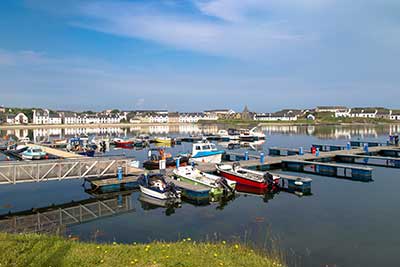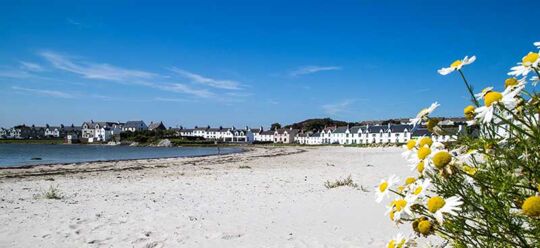Port Ellen

Port Ellen is the largest town on Islay after Bowmore and is situated in a sheltered part of the island, offering views to the Oa Peninsula and to Kilnaughton Bay, which is named after the chapel ruins and burial ground at the end of the bay beside the road to the Oa peninsula.
The town has several shops, hotels, restaurants and pubs and various types of accommodation. It also has Islay CyberCafe, a youth organisation; filling station with camper and car wash facilities; local Post Office that sells gifts and local crafts.
Every Thursday (23 June-25 Aug) you can grab a delicious lunch in Columba Hall in Frederick Crescent, next to the Co-op supermarket. Money raised from the lunches are to support church funds. From time to time the travelling cinema, Screen Machine, visits the island and parks for showings opposite Ramsay Hall, next to the Port Ellen Playing Fields. Another prominent feature is the hotel on the corner, No1 Charlotte Street.
The Port Ellen Marina provides a safe, comfortable haven for yachts passing through the Sound of Jura, it also has a marina office with accessible shower facilities. The Ardview Inn, the one and only ‘Pub’ on the island, has come under new ownership and is due to re-open soon, with a complete renovation.
Port Ellen history
This lovely town, built around Leodamais Bay, was founded in 1821 by Walter Frederick Campbell and named after his wife Ellinor or Eleanor, later shortened to Port Ellen. Just outside Port Ellen on Charlotte Street, you can find Ramsay Hall, built by and named after the family who, in the 19th century, owned the estates in the southern part of Islay.
The area around Port Ellen holds a very varied and interesting range of archaeological sites covering the Neolithic, Bronze and Iron Age periods as well as more recent examples of human settlement. For example, there are standing stones at Kilbride, a fort at Borraichill Mor, several chambered cairns and a chapel at Cill Tobar Lasrach.
Arriving in Port Ellen
For many visitors, Port Ellen is their first acquaintance with the Isle of Islay. When travelling from Kennacraig to Port Ellen the first view of Islay appears on the horizon when leaving West Loch Tarbert and the Isle of Gigha is passed on the left.
About one hour before arrival on Islay the first of the three southern whisky distilleries become visible on the east coast of Islay, this is Ardbeg. A few moments later Lagavulin appears on Islay's coast and Laphroaig is visible after the Isle of Texa has been passed.
The ferry now makes a turn to the right (starboard) and to the left the Oa peninsula rises from the sea with its impressive cliffs up to 200 metres near the American Monument and the Mull of Oa. This monument commemorates the shipwreck of the troopship ‘Tuscania’ and the 266 WW1 American servicemen who lost their lives when the ship was torpedoed in February 1918. Also on the left the beautiful Port Ellen lighthouse appears.
The lighthouse was commissioned in 1832 by Walter Frederick Campbell in loving memory of Lady Eleanor Campbell. Along a track past the lighthouse are the Singing Sands and Carraig Fhada B&B at the side of Kilnaughton Bay with the Port Ellen warehouses on its shore.
Port Ellen Maltings
A prominent Port Ellen building is the former whisky distillery, now Port Ellen Maltings. Here most of the malts are produced for the majority of the distilleries on the island. The maltings are performed according to the specs from the distilleries. Currently under construction is the new Port Ellen Distillery, bringing one of the world’s most famous distilleries back into production and aiming to open in 2022.
On the road heading east from Port Ellen, a narrow lane on the left leads to Kilbride farm. In the field, a few hundred metres from the main road is a prominent standing stone of almost 4.5 m high with Cnoc Mor in the background. This area was a sacred place in much earlier days.
Leaving Port Ellen
Following the main road east you reach the three southern distilleries of Ardbeg, Laphroaig and Lagavulin. The Lagavulin Distillery is located in a secluded bay overlooking the former stronghold of the Lords of the Isles being Dunyvaig Castle. Further east is Kildalton Church and High Cross, Claggain Bay and Ardtalla, where the road ends.
